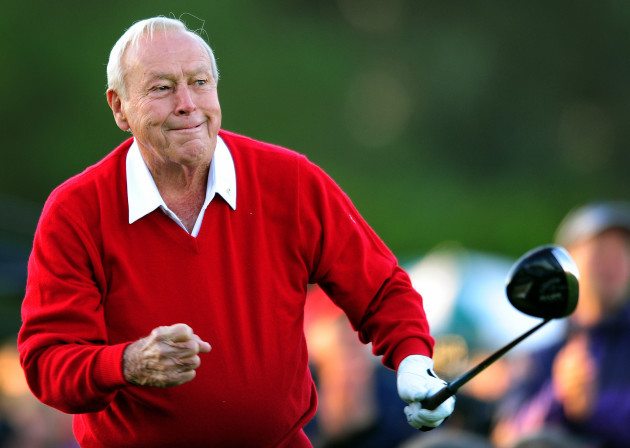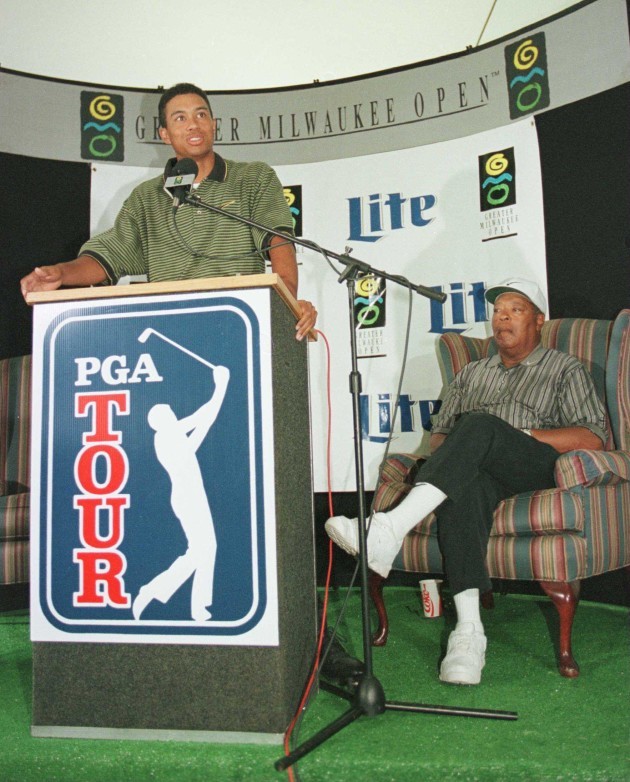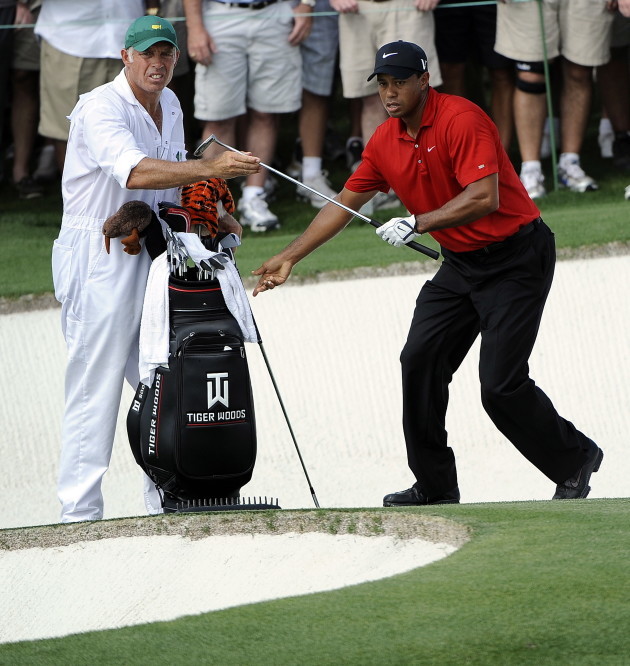THE FOLLOWING PASSAGE is an extract from ‘Tiger Woods’.
It may have been the loudest cheering ever generated by Tiger Woods. At dusk on March 29, 2009, the gallery around the 18th hole at Bay Hill in Orlando could be heard a mile away as Tiger’s 16-foot putt banged in, capping one of the biggest comebacks of his career. In his 239th start, Woods had won his 66th PGA Tour event.
More important, the victory at the Arnold Palmer Invitational was his first tournament win since undergoing knee surgery nine months earlier. The NBC announcers referred to Tiger’s performance as “magical.” In this instance, adjectives like supernatural and otherworldly would not be exaggerations. It had been only three months since he had blown out his Achilles. The stress fractures in his tibia were healed, and he had a reconstructed ACL. Whatever his doctors Mark Lindsay and Tony Galea were doing was working. After starting the final round five strokes behind, Woods had come roaring back, demonstrating more emphatically than ever that he remained the greatest individual performer in all of sports.
As Woods walked off the green to the chant of “Tiger, Tiger, Tiger,” he was greeted by the King, Arnold Palmer.
“What did I say to you last year?” Palmer asked him. “I said Earl would have loved it. He would have loved it.”
Woods smiled and thanked him. It felt exhilarating to be back on top.
In Tiger’s career, the year 2009 will forever be remembered for what happened to him off the course—a mysterious motor vehicle accident, followed by the exposure of an infidelity crisis so big that he would never again be looked at in the same light. But his spectacular fall from grace would not come until the end of the year. Prior to that, Woods played some of the most remarkable golf of his life. He ended up winning seven of the nineteen tournaments he entered that season. In 16 of those tournaments he finished in the top 10. He was first in birdie average, scoring average, iron play from 175 to 200 yards, and greens in regulation; he topped the money list with more than $10 million; and he finished the year ranked number one in the world. It was also the year that he became the first athlete in history to exceed $1 billion in career earnings. By every visible measure, Tiger Woods was alone at the pinnacle of professional sports, the most talented golfer to ever play the game, the greatest athlete of his generation, and the richest athlete of all time.
But Woods was living in denial, deceiving himself and those closest to him. In February, he and Elin had welcomed their second child, Charlie Axel Woods, into the world. It should have been an occasion of immense joy, a family milestone that could have inspired Woods to spend more time with his wife and children. Many of the game’s greatest golfers experienced at least a modest decline in their competitive edge after children came along and priorities changed. “When I was younger, before I had children and money, all I wanted to do was play golf, work at my golf, get better at my golf,” Tom Watson said. “But when the children came, my time with them was very important to me. I definitely lost some edge.” Woods, on the other hand, never lost his competitive drive to dominate his sport, to win every time he stepped onto a golf course. At 33, he was untethered from his family by a narcissism that fed his self-destructive addictions to bodybuilding, painkillers, sleeping pills, and sex.
His upbringing, so critical to his development into a machine-like athlete, forever stunted his ability to form—much less maintain—the kind of intimate relationship with a spouse that is built on self-sacrifice, loyalty, trust, and selflessness; nor was he equipped to cope with fatherhood. He loved his children, but his lifestyle virtually assured that he would be an absentee dad.
In June 2009, Woods was in New York City to attend yet another promotional event, this time for EA Sports. The video-game maker was rolling out a new product, and Tiger was on hand for the launch. Afterwards, on the same day that Michael Jackson died after fatally overdosing on a cocktail of pain and sleep medications, an obviously worn-down Woods talked to People magazine writer Steve Helling. The subject quickly turned to parenting. “My dad passed away before Sam was born,” Tiger told Helling, “so I didn’t have a chance to talk to him about being a father. I regret that. I will always regret that. I think of him every day. He taught me everything. I hear his voice.”
There is a lot to unpack in that statement. Woods, who started taking Ambien to combat sleeplessness back when his father was dying, was still in the grip of insomnia. Racked by regrets stemming from the loss of his father and his own perceived inadequacies as a dad, Woods desperately missed communicating with his best friend. But the saddest part of Tiger’s statement wasn’t what he said but who he said it to. Instead of opening up to his wife or a genuine friend, he was talking to a writer at a celebrity magazine. It was an indication that by 2009, Woods was more alone than ever. Yet he was signalling that he needed help.
On the same day that Tiger talked to Helling, he met up with his friend Derek Jeter. They ended up at a Manhattan nightclub with three women in their 20s. One of the women in the group was Mark O’Meara’s niece, Amber Lauria. Tiger had known Lauria since 1997, when they were introduced to each other at O’Meara’s home. Woods had spent countless hours with Lauria at Isleworth and around Orlando during her teenage years. From the beginning, their bond was more like a brother-and-sister relationship than a friendship. By 2009, Lauria had graduated from college and was working at Fox News, and they would meet up from time to time when Woods was in New York. He also communicated with her frequently by phone and text.
After Earl died, Lauria said, her conversations with Tiger took on a more depressing tone. From that point on, he seldom seemed happy.
“He looked at me like a family member,” Lauria said. “But I remember thinking he’s in a really bad spot to be calling and crying and being this upset for this long. That’s when I really started seeing a big change in him. He would just go to a dark place.” Lauria admired Elin and remembered thinking, I wish Elin were here with him at a time when he’s so upset. But she also recognised that it wasn’t practical for Elin to be on the road with Tiger. She had two young children at home.
Lauria agreed to meet up with Woods at the nightclub because she still cared about him as a friend. “He was alone, and he needed people around him,” she said. Still, it was clear that things were amiss. “I said to him, ‘I’m here for you, but you should be with your wife or calling your wife. I know you’re travelling. But what’s going on?’”
Emotionally, Woods was adrift, constantly moving from city to city, hooking up with one woman after another. Most of the women whose names and numbers filled his cell phone directory were ones he had met in nightclubs and casinos. He persuaded one after another to believe that she was his only mistress. All of these women—the ones he paid and the ones he picked up—were women he could control. For the most part, they were younger than he was, less sophisticated, enamoured of his status, and in the dark about his exploits. It was a situation that made it easier to maintain his secret life.
But during his visit to New York City that week in June 2009, he met a woman who represented something different. 34-year-old Rachel Uchitel, a glamorous beauty, had grown up a child of privilege in Manhattan. Well-educated and possessing a degree in psychology, she first encountered fame after the 9/11 terror attacks. The New York Post ran a photo of her weeping while holding a picture of her missing fiancée, who worked in the World Trade Centre, and the image was distributed around the world via the internet. Uchitel went on to become a television producer at Bloomberg before transitioning to VIP hostess/manager at high-end nightclubs from the Hamptons to New York to Las Vegas, earning high praise for her people skills and attention to detail. Uchitel gained another measure of fame when it was reported that she’d had an affair with actor David Boreanaz. She also knew Derek Jeter.
Woods was taken with Uchitel. She was a year older than he was, and she lived a lifestyle that was more akin to his than the other women he knew. She was a jet-setter, accustomed to flying around the world and running in the same circles as celebrities and CEOs. By the time Tiger left New York, he’d added Uchitel to the directory on his phone, and she’d added him to hers, under the code name Bear.
Uchitel started flying down to Orlando, where Tiger would put her up in a condo near his home. When Woods arrived, he would close the blinds. They would stay up watching late-night comedy on television. And despite being plagued by insomnia, Tiger didn’t have trouble going to sleep when he was with Uchitel. Their sexual intimacy and mutual familiarity with grief—he was still suffering from the loss of his father, and she had lost her fiancée in an act of terrorism, as well as her father to a cocaine overdose—enabled them to bond in a way that provided a deeper element to their relationship. On one occasion, while with Uchitel in the Orlando condo, Tiger said, “This makes me so happy.” It was a sad admission, considering he was practically around the corner from his home, where Elin was taking care of their newborn son and two-year-old daughter, blissfully unaware.
At this point, Hank Haney didn’t know what was going on either, but he recognised a drop-off in Tiger’s practice hours and in his effort. “There were times at Isleworth,” Haney said, “when I’d say, ‘Where is he?’ I mean, he’d say he’s going to the store and be gone for an hour or two. Or Elin would be out of town, and he’d be getting ready to go out. ‘Where are you going?’ I’d ask. And he would make up some story about how he was going over to Bryon Bell’s house. I could tell he was lying.”
Yet it never crossed Haney’s mind that Woods might be meeting up with other women. Haney was around Tiger more than almost anyone, and he said he never witnessed any flirting, never mind infidelity. “I never saw him with anybody,” Haney said. “I’m the kind of friend that if I saw something, I would say something. Steve Williams was the same way.”
The one thing that Woods couldn’t hide from Haney and Williams was his increasingly surly behaviour on the golf course. Almost immediately after Woods returned to the Tour in 2009, both his swing coach and his caddie started seeing red flags about his emotional state. The first one went up at the 2009 Masters. After playing poorly at Augusta, Woods went on a rant to the press: “I fought my swing all day and just kind of Band-Aided it around, and almost won the tournament with a Band-Aid swing.” Without naming Haney, Woods had given him a backhanded insult, igniting rumours that Haney was on the verge of being fired.
Haney responded with an email to Woods: “You didn’t make any friends or fans with the way you acted at the Masters. You just looked stressed and pissed the whole time you were there.”
It became even clearer that Woods was reaching the end of his emotional rope at the 2009 PGA Championship at Hazeltine National Golf Club outside Minneapolis. After scores of 67 and 70 in the first two rounds, Woods held a four-shot lead going into the third round. He appeared to be well on his way to closing to within three majors of Nicklaus’s record. But in Friday’s post-round press conference, an enterprising reporter summoned the courage to inquire if Woods ever felt he had choked in a major.
Furious, Woods just stared him down.
Finally, moderator Kelly Elbin broke the awkward silence. “We’ll take that to be a no?” he said.
“Be creative,” Woods finally said to the reporter. “You usually are.” But the question would prove prescient.
After the third round, Woods maintained a two-stroke lead, and the outcome seemed like a foregone conclusion. Tiger had never lost a major when leading after three rounds. He entered the final round two strokes ahead of South Korea’s Yang Yong-eun, better known as Y. E. Yang. Yang, who was 37, hadn’t picked up a club until he was 19, and hadn’t broken par until he was 22. Earlier in the year, Yang had been forced to sink a seven-foot putt on the final hole of the last day of qualifying school just to make the Tour. He had a grand total of one victory on the PGA Tour. He was the longest of long shots to beat Woods.
All day long, Woods and Steve Williams barely said a word to Yang, employing the kind of gamesmanship—isolation, slow play, crowding— Tiger was famous for. But Yang never got rattled. After 12 holes, he had pulled even with Woods. On 13, Woods stuffed a 3-iron from 248 yards to within eight feet of the hole. When Yang buried his tee shot in a greenside bunker, it appeared a birdie-bogey swing was in the works and Woods was on his way to his 15th major. But then Yang hit the shot of his life, blasting out of the bunker to 12 feet. Moments later, he snaked in a tough putt for par.
Still, all Woods had to do to stay even with Yang was make an eight-foot birdie putt, the kind he’d dropped hundreds of times under pressure. Only this time, the unthinkable happened. Woods missed. His putt burned the left edge of the cup and failed to fall. The look on Woods’s face was a mix of anger and disbelief.
Inside the clubhouse, players—many of whom had crumbled in similar pressure-packed situations against Woods—were jumping up and down on a couch, cheering Yang on, hoping somebody, anybody, even the South Korean son of a vegetable farmer, would finally slay the dragon.
With five holes still to play, Woods had plenty of time to overtake Yang. But something was amiss; the failure to drop the kind of putt he hadn’t missed, even under pressure, in two decades had shaken something loose in Tiger. When Yang chipped in for eagle on the next hole, Woods never recovered, missing two more critical, makeable putts on the last four holes. He ended up losing to Yang by three strokes. His perfect record of 14–0 in winning majors after holding or sharing the third-round lead was broken.
Steve Williams later told a friend that he thought the loss of the PGA Championship to Yang was the first crack in the armour. It was the beginning of what he called the Snowball Effect. In his 2006 book Golf at the Top, Williams described the effect as an unexpected moment that “allows a flash of self-doubt to enter the conscious mind and then to penetrate all the way to the imagination.” Then, having opened a wound in the most sensitive part of the brain, the person begins to “listen more and more closely to the negative interpretations the imagination is placing on events and project them onto the next shot and the next round and the next tournament.”
In other words, when you miss once when it really counts—like an eight-foot birdie putt late at the PGA Championship—the dark whispers in your mind grow louder and louder. As summer turned to fall, Woods was hearing such whispers seemingly at every turn.
‘Tiger Woods’ by Jeff Benedict and Armen Keteyian is published by Simon & Schuster. More info here.





